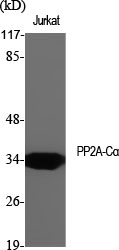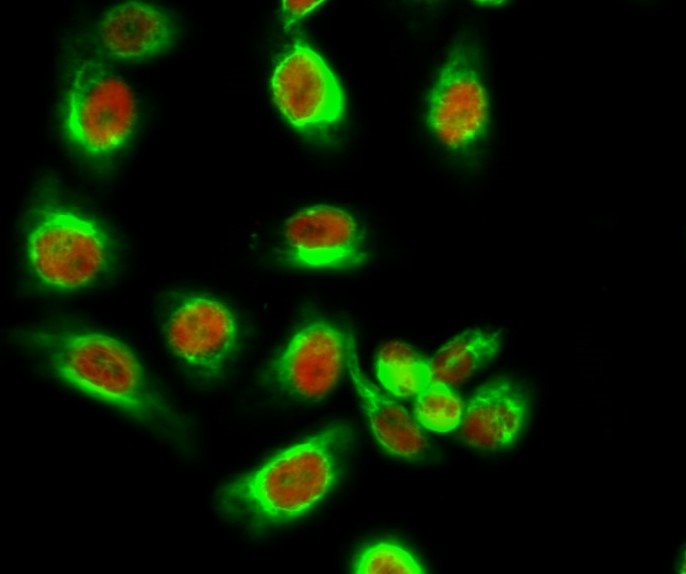Phospho PP2A-α (Y307) Cell-Based Colorimetric ELISA Kit
- Catalog No.:KA1325C
- Applications:ELISA
- Reactivity:Human;Mouse;Rat
- Gene Name:
- PPP2CA
- Human Gene Id:
- 5515
- Human Swiss Prot No:
- P67775
- Mouse Swiss Prot No:
- P63330
- Rat Swiss Prot No:
- P63331
- Storage Stability:
- 2-8°C/6 months
- Other Name:
- Serine/threonine-protein phosphatase 2A catalytic subunit alpha isoform (PP2A-alpha) (EC 3.1.3.16) (Replication protein C) (RP-C)
- Detection Method:
- Colorimetric
- Background:
- catalytic activity:A phosphoprotein + H(2)O = a protein + phosphate.,cofactor:Binds 1 iron ion per subunit.,cofactor:Binds 1 manganese ion per subunit.,function:PP2A can modulate the activity of phosphorylase B kinase casein kinase 2, mitogen-stimulated S6 kinase, and MAP-2 kinase. Can dephosphorylate SV40 large T antigen and p53. Dephosphorylates SV40 large T antigen, preferentially on serine residues 120, 123, 677, and perhaps 679. The C subunit was most active, followed by the AC form, which was more active than the ABC form, and activity of all three forms was strongly stimulated by manganese, and to a lesser extent by magnesium. Dephosphorylation by the AC form, but not C or ABC form is inhibited by small T antigen.,PTM:Phosphorylation of either threonine (by autophosphorylation-activated protein kinase) or tyrosine results in inactivation of the phosphatase. Auto-dephosphorylation has been suggested as a mechanism for reactivation.,PTM:Reversibly methyl esterified on Leu-309. Carboxyl methylation may play a role in holoenzyme assembly. It varies during the cell cycle.,similarity:Belongs to the PPP phosphatase family.,similarity:Belongs to the PPP phosphatase family. PP-1 subfamily.,subcellular location:In prometaphase cells, but not in anaphase cells, localizes at centromeres. During mitosis, also found at spindle poles.,subunit:PP2A consists of a common heterodimeric core enzyme, composed of a 36 kDa catalytic subunit (subunit C) and a 65 kDa constant regulatory subunit (PR65 or subunit A), that associates with a variety of regulatory subunits. Proteins that associate with the core dimer include three families of regulatory subunits B (the R2/B/PR55/B55, R3/B''/PR72/PR130/PR59 and R5/B'/B56 families), the 48 kDa variable regulatory subunit, viral proteins, and cell signaling molecules. Interacts with NXN; the interaction is direct (By similarity). May indirectly interact with SGOL1, most probably through regulatory B56 subunits.,
- Function:
- MAPKKK cascade, inactivation of MAPK activity, regulation of cell growth, regulation of protein amino acid phosphorylation, negative regulation of protein amino acid phosphorylation, regulation of DNA replication, RNA processing, negative regulation of protein kinase activity, protein amino acid dephosphorylation, membrane lipid metabolic process, sphingolipid metabolic process, ceramide metabolic process, phosphorus metabolic process,phosphate metabolic process, induction of apoptosis, intracellular signaling cascade, protein kinase cascade,mesoderm development, regulation of cell size, RNA splicing, negative regulation of signal transduction, response to organic substance, negative regulation of phosphorus metabolic process, negative regulation of macromolecule metabolic process, regulation of protein kinase cascade, negative regulation of cell communication, negative regulation of pro
- Subcellular Location:
- Cytoplasm . Nucleus . Chromosome, centromere . Cytoplasm, cytoskeleton, spindle pole . In prometaphase cells, but not in anaphase cells, localizes at centromeres (PubMed:16541025). During mitosis, also found at spindle poles (PubMed:16541025). Centromeric localization requires the presence of SGO2 (By similarity). .
Tolfenamic acid inhibits GSK-3β and PP2A mediated tau hyperphosphorylation in Alzheimer’s disease models. Journal of Physiological Sciences J Physiol Sci. 2020 Dec;70(1):1-11 ELISA Rat PC12 cell
- June 19-2018
- WESTERN IMMUNOBLOTTING PROTOCOL
- June 19-2018
- IMMUNOHISTOCHEMISTRY-PARAFFIN PROTOCOL
- June 19-2018
- IMMUNOFLUORESCENCE PROTOCOL
- September 08-2020
- FLOW-CYTOMEYRT-PROTOCOL
- May 20-2022
- Cell-Based ELISA│解您多样本WB检测之困扰
- July 13-2018
- CELL-BASED-ELISA-PROTOCOL-FOR-ACETYL-PROTEIN
- July 13-2018
- CELL-BASED-ELISA-PROTOCOL-FOR-PHOSPHO-PROTEIN
- July 13-2018
- Antibody-FAQs


